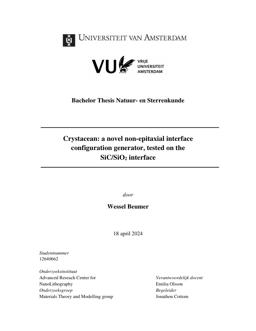2024-04-18
Crystacean: a novel non-epitaxial interface configuration generator, tested on the SiC/SiO2 interface
Publication
Publication
As advanced computational techniques have led to significant advances in the field of material science, contemporary methods of generating hetero-interfaces involving amorphous materials have fallen short. Crystacean is a Rust based Python library which aims to fill this gap in the available computational tools. To demonstrate the method developed, the library is used to find configurations of the SiC/SiO2 interface. Crystacean can generate multiple amorphous SiO2 layers on top of a SiC substrate lattice. This is done by first identifying where the silicon atoms of the SiO2 could be placed, and then creating exclusion rules. These sites and exclusion rules are then represented with bitvectors, allowing memory and compute efficient searching of configurational space. This thesis also demonstrates how Crystacean can generate more configurations for a lattice than would be practical by hand and the generation of layers beyond the direct interface, and why these capabilities might be desired. Possible broader applicability beyond the SiC/SiO2 interface system is also discussed.
| Additional Metadata | |
|---|---|
| E. Olsson (Emilia) , J. Cottom (Jonathon) | |
| VU University Amsterdam , University of Amsterdam, UvA | |
| Organisation | Materials Theory and Modeling |
|
Beumer, W. (2024, April 18). Crystacean: a novel non-epitaxial interface configuration generator, tested on the SiC/SiO2 interface. |
|

